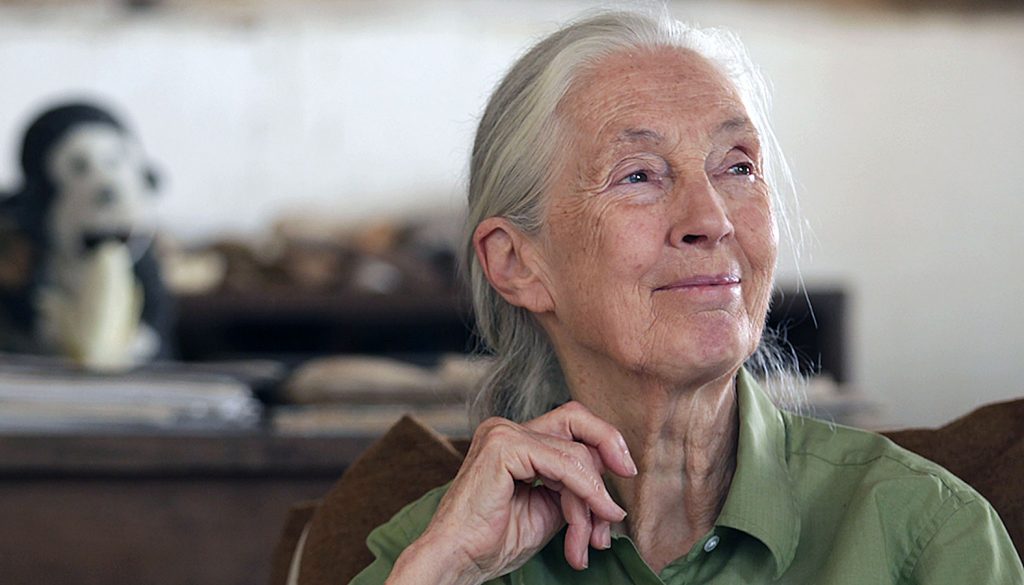It’s not too late to catch “Becoming Jane: The Evolution of Dr. Jane Goodall,” an immersive multimedia exhibition running through April 17 at the LA Natural History Museum.
What’s not to like about the aptly named Goodall?
There’s the unusual childhood, marked by an absent father and a constellation of female relatives who encouraged and fostered the young Goodall’s independence. In an iconic photo taken just after her first birthday, she’s cuddling Jubilee, the stuffed chimpanzee she’d received as a gift and that eerily presaged her vocation.
At 5 she disappeared one day. Her mother and aunts were so panic-stricken they even called the police. Goodall reappeared hours later, covered with straw and bursting with excitement. Curious as to how hens laid eggs, she’d been in the henhouse and had patiently waited until she’d found out!
There’s her dream, as a high school student, to study and write about animals in Africa; the limited opportunities available to women in that era; the chance invitation, from a boarding-school chum, to visit Kenya. Goodall arrived in Nairobi on her 23rd birthday.
A more or less chance meeting with British paleontologist Dr. Louis Leakey (1903-1972) followed. At the time the curator of what is now the National Museum of Kenya, Leakey was searching for fossils of the first humans, and intuited that a comprehensive study of the lives and behavior of apes would aid his project.
Leakey recruited Goodall for the job, precisely because she was a woman and not a trained scientist. Instinctively he sensed that she possessed both the patience and the endurance required for such an undertaking.
Officials insisted that Goodall bring a chaperone. Thus her own mother, Vanne, accompanied her to the Gombe Stream Game Reserve, now known as the Gombe National Park, in Tanzania.
“My family has very strong women,” Goodall observed as she looked back on her beginnings. “My mother never laughed at my dream of Africa, even though everyone else did because we didn’t have any money … and because I was a girl.”
That Goodall was (and still is) ridiculously photogenic contributed to her allure. Living in a tent, scrambling up cliffs, sitting in the African bush for hours on end with nothing more than a thermos of tea and a pair of binoculars, she appeared perpetually to have stepped from a bandbox: hair pulled neatly back into a fetching ponytail, crisp linen shirt and shorts, slim tanned legs. She seemed imperturbable: just the way we would have liked to appear, had we been cool, calm, collected, intrepid, female jungle-dwelling primatologists.
Though without formal training, Goodall was invited to Tanzania in 1960 to observe the chimpanzees. She was outwardly unassuming, inwardly driven, and fearless.
Her feminine genius served superbly in her studies of animals in the wild. She was almost preternaturally patient, content to sit day after day, scanning through her binoculars, without a single sighting.
This patient endurance paid off. She eventually learned where the chimps foraged for food, gathered, and rested. She began to know them as individuals, to observe the way they related to one another. She named them.
To her astonishment, she learned that they not only used tools, but made them: One chimp, for example, stripped a twig of leaves in order to dip it into a termite mound and pull out some snacks. She learned that the chimps engaged in ritual. She eventually learned to her sorrow that, like humans, chimpanzees could become territorial, aggressive, jealous, and lethally violent.
Her studies were initially ridiculed by the male-dominated scientific world, but Goodall quietly forged on. That she is today recognized as one of the most important primatologists of the 20th century and the world’s foremost expert on chimpanzees is a singular triumph.
The Natural History Museum exhibit is produced in partnership with the National Geographic Society and the Jane Goodall Institute. It covers her early life, the years in Gombe, Tanzania, during which she established herself as an internationally known and respected scientist, and her current role as an activist, mentor, and globe-trotting ambassador for the cause of creating “a better world for all life on Earth.”
Highlights include multiscreen videos, digitally rendered chimpanzees, personal reminiscences from Goodall and a replica of her research tent, various interactive immersive activities, an update on the state of Gombe Stream National Park, the chimpanzee range in Africa, and the work of the scientists and conservationists who are following in Goodall’s footsteps, and a call to action to work toward a sustainable future for everyone on the planet.
Born in 1934, at 87, Goodall’s work pace has barely slowed. Though COVID-19 put a temporary halt to her 300-day-a-year travel schedule, she recently joined the LA Times Book Club for a virtual presentation about her most recent project, “The Book of Hope: A Survival Guide for Trying Times.”
In her Earth Day 2021 statement, she observed, “[W]e must go forward towards a world in which the Earth is not seen as an abstract — not just a pale blue dot — but one teeming with diverse and magnificent life that we must protect.”

